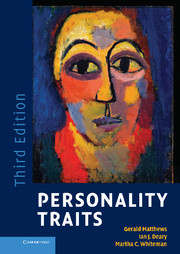Book contents
- Frontmatter
- Contents
- List of figures
- List of tables
- List of boxes
- Preface to the third edition
- Preface to the second edition
- Preface to the first edition
- Part I The nature of personality traits
- Part II Causes of personality traits
- Part III Consequences and applications
- 14 Conclusions
- References
- Author index
- Subject index
Preface to the third edition
Published online by Cambridge University Press: 05 June 2012
- Frontmatter
- Contents
- List of figures
- List of tables
- List of boxes
- Preface to the third edition
- Preface to the second edition
- Preface to the first edition
- Part I The nature of personality traits
- Part II Causes of personality traits
- Part III Consequences and applications
- 14 Conclusions
- References
- Author index
- Subject index
Summary
The first and second editions of Personality Traits explicated and consolidated our opinion that the science of personality could be built on a foundation of traits. The first edition had the job of defining the field. It grew out of the growing consensus regarding traits as entities, and particularly well-validated personality trait models. The second edition was more comfortable in the presence of its psychological neighbours. It absorbed the confidence building around traits and trait models and reached out to companion disciplines that could inform personality trait science and also benefit from it. That maturity and integration was the dual driving force for this third edition. It is no longer necessary primarily to be marking territory, to be showing what is and what is not trait land. In this third edition, with personality traits and their models more securely established and connected within psychology, there is more reaching out: to the revisionary critics, who have some interesting new ideas; to the fast-growing sciences that can offer explanations for trait differences; and to the applied fields that are increasingly enjoying the benefits of including personality trait variance in their models. The structure of the book has been retained. Readers will first find out about the distinctive characteristics of traits, then their biological and social foundations, and then how they play out into human life: what traits are and which ones there are, how differences in them come about, and why they matter.
- Type
- Chapter
- Information
- Personality Traits , pp. xxv - xxviiPublisher: Cambridge University PressPrint publication year: 2009



